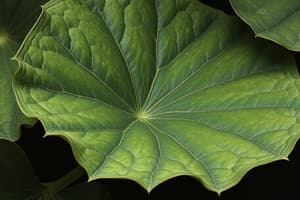Podcast
Questions and Answers
What type of leaf venation pattern is characterized by at least three primary veins arising from a common point at the base of the lamina?
What type of leaf venation pattern is characterized by at least three primary veins arising from a common point at the base of the lamina?
- Pinnately netted
- Palmately netted (correct)
- Decussate
- Distichous
What is the term for a leaf that is divided into multiple leaflets attached to a common point?
What is the term for a leaf that is divided into multiple leaflets attached to a common point?
- Palmate
- Simple
- Trifoliate
- Compound (correct)
What type of leaf attachment structure is characteristic of a leaflet?
What type of leaf attachment structure is characteristic of a leaflet?
- Petiole
- Rachis
- Petiolule (correct)
- Stipule
What is the term for a leaf with a central axis and leaflets arranged along it?
What is the term for a leaf with a central axis and leaflets arranged along it?
What type of leaf modification is characterized by a leaf that is different from the main photosynthetic leaves and is often associated with flowers or inflorescences?
What type of leaf modification is characterized by a leaf that is different from the main photosynthetic leaves and is often associated with flowers or inflorescences?
What is the term for a leaf arrangement where three or more leaves are attached to a single node?
What is the term for a leaf arrangement where three or more leaves are attached to a single node?
What type of leaf arrangement is characterized by each leaf being slightly rotated from the node?
What type of leaf arrangement is characterized by each leaf being slightly rotated from the node?
What is the term for a leaf with a sharp-pointed leaf or leaf part?
What is the term for a leaf with a sharp-pointed leaf or leaf part?
What type of leaf is adapted to store water and minimize water loss?
What type of leaf is adapted to store water and minimize water loss?
What is the term for a coiled and twining leaf or leaf part that develops from an auxiliary bud?
What is the term for a coiled and twining leaf or leaf part that develops from an auxiliary bud?
What is the term for a structure formed by overlapping leaf bases that provides and transports nutrients from the soil?
What is the term for a structure formed by overlapping leaf bases that provides and transports nutrients from the soil?
What is the main difference between microphyllous and megaphyllous leaves?
What is the main difference between microphyllous and megaphyllous leaves?
What type of leaf venation pattern is characterized by primary and secondary veins that are more or less parallel to each other?
What type of leaf venation pattern is characterized by primary and secondary veins that are more or less parallel to each other?
What is the term for a leaf that has a petiole?
What is the term for a leaf that has a petiole?
What is the function of stomata in leaves?
What is the function of stomata in leaves?
What is the term for a leaf with two distinct sides that differ morphologically?
What is the term for a leaf with two distinct sides that differ morphologically?
What is the term for a leaf-like appendage found at the base of a petiole?
What is the term for a leaf-like appendage found at the base of a petiole?
Flashcards are hidden until you start studying
Study Notes
Leaf Characteristics
- Leaves can be classified as Simple (not divided into more than one blade) or Compound (composed of leaflets).
- Simple leaves can have a petiole or be sessile (no petiole).
Leaf Venation Patterns
- Pinnately netted: second veins arise along the length of the midrib.
- Palmately netted: at least three primary veins arise from a common point at the base of the lamina.
Leaf Arrangement
- Distichous: each leaf is parallel to the next leaf.
- Opposite: two leaves in each node.
- Decussate: each leaf pair is perpendicular to the next pair.
Compound Leaves
- Trifoliate: three leaflets attached to a common point.
- Palmate: four or more leaflets attached to a common point.
- Pinnate: leaflets arranged along a central axis called the rachis.
- Bipinnate: pinnately compound leaf with two orders of axes.
- Polypinnate: pinnately compound leaf with three or more orders of axes.
Specialized Leaves
- Modified leaves have unusual characteristics to perform functions other than photosynthesis.
- Examples include bracts (associated with flowers or inflorescences), bulb scales (storage leaves attached to bulbs), and succulent leaves (thick and fleshy to store water).
Leaf Arrangement on Stem (Phyllotaxy)
- Alternate: only one leaf in each node.
- Spiral: each leaf is rotated slightly from the node.
- Whorled: three or more leaves in a single node.
Leaf Morphology
- Apex: the end of the lamina farthest from its point of attachment.
- Base: the opposite end of the apex.
- Midrib: the central vein.
- Petiole: the stem-like structure through which leaves are attached to the stem.
Monocot and Dicot Leaves
- Monocot leaves have a single layer of mesophyll and parallel veins.
- Dicot leaves have two layers of mesophyll (palisade and spongy) and a network of veins from the midrib.
Leaf Functions
- Photosynthesis (chloroplasts-containing cells)
- Transpiration (stomata)
Studying That Suits You
Use AI to generate personalized quizzes and flashcards to suit your learning preferences.





